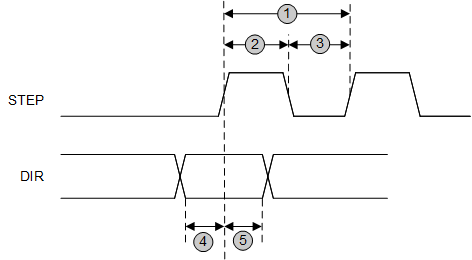SLOSE54C June 2020 – July 2022 DRV8428
PRODUCTION DATA
- 1 Features
- 2 Applications
- 3 Description
- 4 Revision History
- 5 Pin Configuration and Functions
- 6 Specifications
-
7 Detailed Description
- 7.1 Overview
- 7.2 Functional Block Diagram
- 7.3
Feature Description
- 7.3.1 Stepper Motor Driver Current Ratings
- 7.3.2 PWM Motor Drivers
- 7.3.3 Microstepping Indexer
- 7.3.4 Controlling VREF with an MCU DAC
- 7.3.5 Current Regulation, Off-time and Decay Modes
- 7.3.6 Linear Voltage Regulators
- 7.3.7 Logic Level, tri-level, quad-level and seven-level Pin Diagrams
- 7.3.8 Protection Circuits
- 7.4 Device Functional Modes
- 8 Application and Implementation
- 9 Power Supply Recommendations
- 10Layout
- 11Device and Documentation Support
- 12Mechanical, Packaging, and Orderable Information
Package Options
Mechanical Data (Package|Pins)
Thermal pad, mechanical data (Package|Pins)
Orderable Information
6.6 Indexer Timing Requirements
Typical limits are at TJ = 25°C and VVM = 24 V. Over
recommended operating conditions unless otherwise noted.
| NO. | MIN | MAX | UNIT | ||
|---|---|---|---|---|---|
| 1 | ƒSTEP | Step frequency | 500(1) | kHz | |
| 2 | tWH(STEP) | Pulse duration, STEP high | 970 | ns | |
| 3 | tWL(STEP) | Pulse duration, STEP low | 970 | ns | |
| 4 | tSU(DIR, Mx) | Setup time, DIR or MODEx to STEP rising | 200 | ns | |
| 5 | tH(DIR, Mx) | Hold time, DIR or MODEx to STEP rising | 200 | ns | |
(1) STEP input can operate up to 500 kHz, but system bandwidth is limited by the motor load.
 Figure 6-1 STEP and DIR Timing Diagram
Figure 6-1 STEP and DIR Timing Diagram